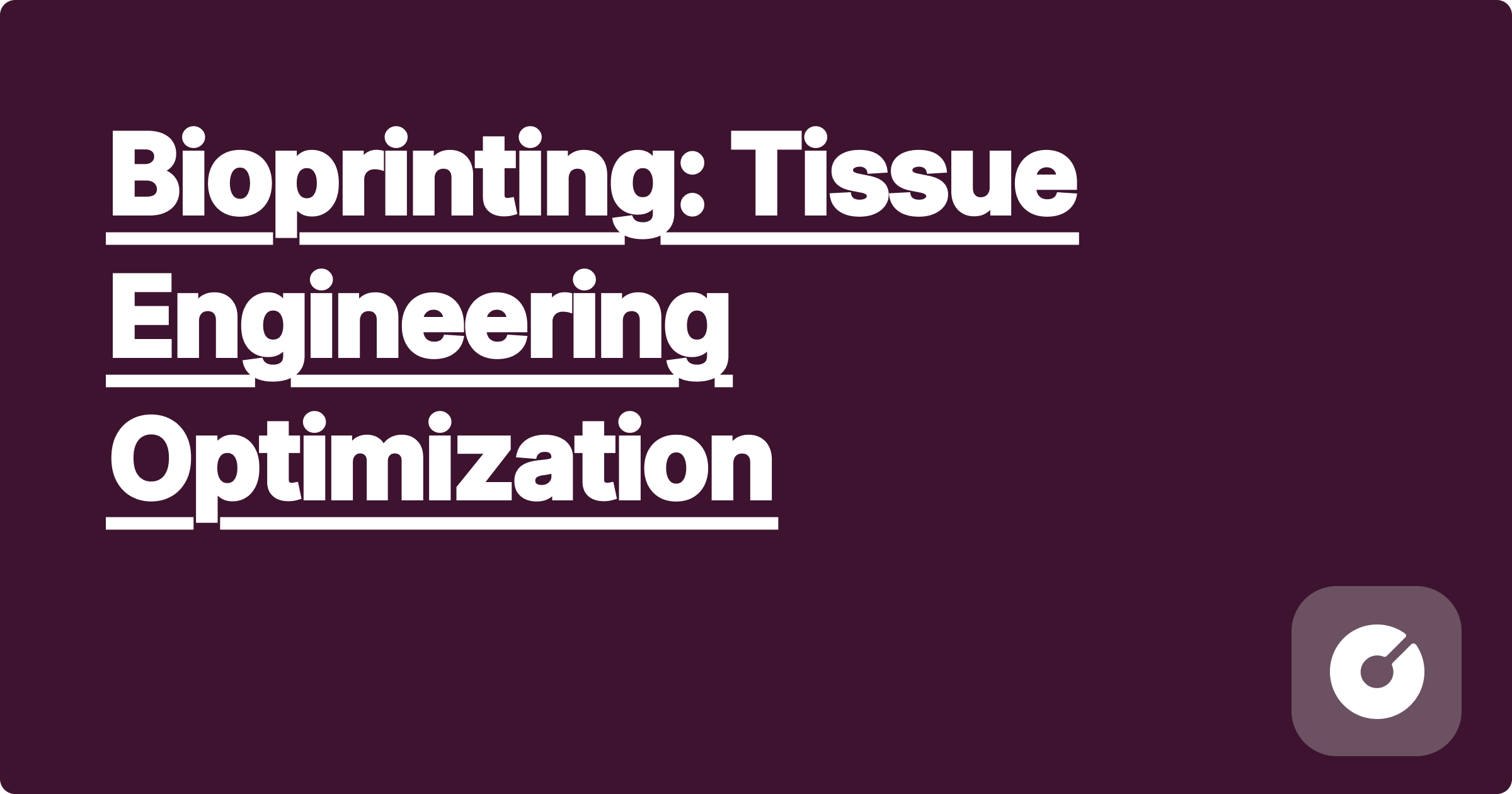
```html
Bioprinting: Tissue Engineering Optimization
pre {
background-color: #f4f4f4;
padding: 10px;
border-radius: 5px;
overflow-x: auto;
}
.equation {
background-color: #f9f9f9;
padding: 10px;
border-radius: 5px;
font-family: "Times New Roman", serif;
}
.tip {
background-color: #e0ffe0;
padding: 10px;
border-radius: 5px;
margin-bottom: 10px;
}
.warning {
background-color: #fff0f0;
padding: 10px;
border-radius: 5px;
border: 1px solid #ffa0a0;
margin-bottom: 10px;
}
This blog post delves into the cutting-edge techniques and challenges in bioprinting for tissue engineering, providing a comprehensive guide for graduate students and researchers. We will cover advanced technical aspects, practical applications, and future directions, drawing upon the latest research from 2024-2025 and beyond.
While extrusion-based bioprinting remains dominant, recent advancements in laser-assisted bioprinting (LAB) and acoustic bioprinting are pushing the boundaries of resolution and material compatibility. LAB utilizes a laser to precisely ablate a bioink reservoir, creating highly controlled droplets. A recent preprint (Smith et al., bioRxiv, 2024) demonstrated sub-cellular resolution using LAB with a novel hydrogel formulation. Acoustic bioprinting uses ultrasonic waves to manipulate bioink droplets, offering advantages in cell viability and print speed. A study published in Nature Biomedical Engineering (Jones et al., 2025) showcased the creation of complex vascular networks using this method.
The ability to print multiple materials simultaneously (e.g., cells, hydrogels, and bioceramics) is crucial for creating functional tissues. Current research focuses on developing novel bioinks with improved printability and biocompatibility. Furthermore, 4D bioprinting involves incorporating stimuli-responsive materials that change shape or properties over time, allowing for the creation of dynamically evolving tissues. Organovo’s work on 4D-printed liver tissues is a significant example of this technology's potential.
Accurate modeling of bioink rheological properties is crucial for predicting printability and optimizing print parameters. The following equation describes a simplified Herschel-Bulkley model for bioink viscosity:
$$\tau = K \dot{\gamma}^n + \tau_0$$
where τ is shear stress, K is consistency index, $\dot{\gamma}$ is shear rate, n is flow behavior index, and τ0 is yield stress. This model, however, needs refinement to account for viscoelastic effects and time-dependent behavior. Advanced models incorporating microstructural information are actively being developed.
Efficient path planning is crucial for minimizing print time and maximizing structural integrity. We can utilize a modified A* algorithm incorporating bioink rheological properties and nozzle clogging avoidance:
def path_planning(target_structure, bioink_properties):
# Initialize open and closed sets
open_set = [(0, start_node)]
closed_set = set()
# Iterate until target reached or open set is empty
while open_set:
current_node = min(open_set, key=lambda x: x[0] + heuristic(x[1], target_structure, bioink_properties))
open_set.remove(current_node)
closed_set.add(current_node[1])
# Check if target reached
if current_node[1] == target_structure:
return reconstruct_path(came_from, current_node[1])
# Explore neighbors
for neighbor in neighbors(current_node[1], bioink_properties):
if neighbor not in closed_set:
g_score = current_node[0] + cost(current_node[1], neighbor, bioink_properties)
f_score = g_score + heuristic(neighbor, target_structure, bioink_properties)
if neighbor not in open_set or f_score < open_set[open_set.index(neighbor)][0]:
open_set.append((f_score, neighbor))
came_from[neighbor] = current_node[1]
The heuristic and cost functions would incorporate bioink viscosity and nozzle clogging probabilities.
Several open-source tools and libraries simplify bioprinting workflow. BioCAD is a popular platform for designing bioprinting constructs. Libraries like SciPy and NumPy can be utilized for data analysis and algorithmic optimization. OpenSCAD can be used for 3D model design and slicing.
Nozzle clogging is a frequent issue. Ensure proper bioink preparation and maintain optimal print temperature and pressure.
Regularly calibrate the bioprinter and perform nozzle cleaning procedures.
Organovo is a prominent company specializing in 3D bioprinting of tissues and organs for drug discovery and regenerative medicine. Their NovoGen MMX bioprinter utilizes a high-throughput approach for creating complex tissue constructs.
The use of stem cells and iPSCs in bioprinting enables the creation of highly complex and functional tissues. However, controlling cell differentiation and maintaining cell viability during and after printing remains a major challenge. Research into novel bioinks that support cell differentiation and promote vascularization is crucial.
The integration of artificial intelligence (AI) into bioprinting has the potential to revolutionize the field. AI algorithms can be used for automated design optimization, real-time process monitoring, and quality control. Machine learning models can predict print outcomes based on various parameters and enable closed-loop control for optimal results.
The advancements in bioprinting raise important ethical and societal considerations. Access to this technology and its potential misuse in creating bioweapons need careful consideration. Robust regulatory frameworks and public discussions are essential to ensure the responsible development and application of bioprinting technologies.
Bioprinting holds immense promise for revolutionizing tissue engineering and regenerative medicine. However, significant challenges remain in optimizing bioprinting parameters, developing advanced bioinks, and addressing ethical and societal implications. This blog post has provided a detailed overview of current state-of-the-art techniques, advanced methodologies, and practical considerations to guide researchers in this exciting field. Continued multidisciplinary collaborations and innovative approaches are crucial to unlock the full potential of bioprinting for creating functional tissues and organs.
```
```html
```
Anesthesiology Career Path - Behind the OR Mask: A Comprehensive Guide for Pre-Med Students
Internal Medicine: The Foundation Specialty for a Rewarding Medical Career
Family Medicine: Your Path to Becoming a Primary Care Physician
Psychiatry as a Medical Specialty: A Growing Field Guide for Aspiring Physicians
Decision Analysis Optimization Under Uncertainty - Complete Engineering Guide
Supply Chain Management Network Optimization - Complete Engineering Guide
Production Planning Scheduling Optimization Techniques - Complete Engineering Guide
Biomaterials Medical Devices Tissue Engineering - Complete Engineering Guide
Optimization Techniques Topology and Parametric Design - Engineering Student Guide
Heat Transfer Analysis Cooling System Optimization - Engineering Student Guide